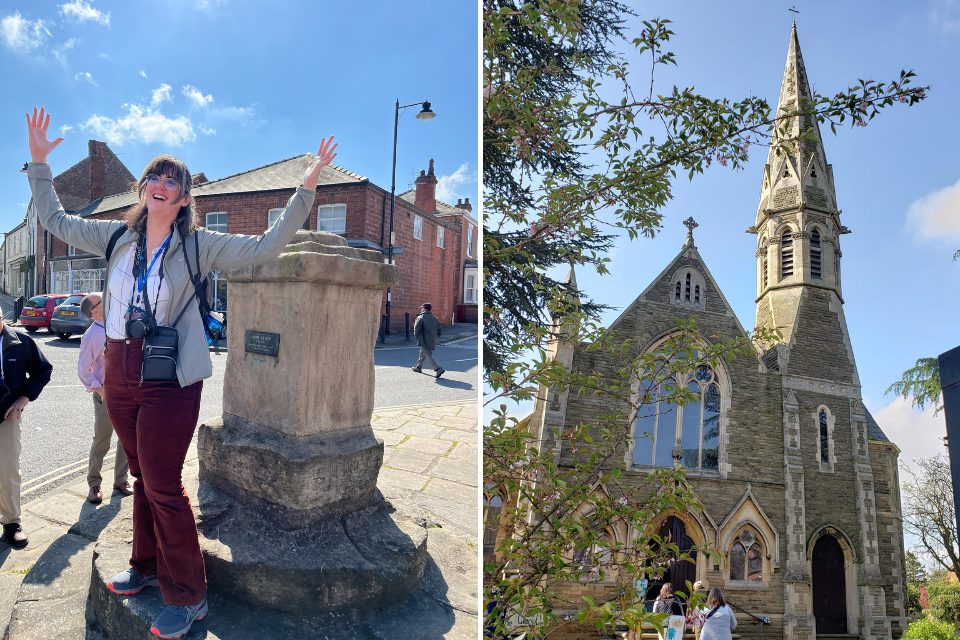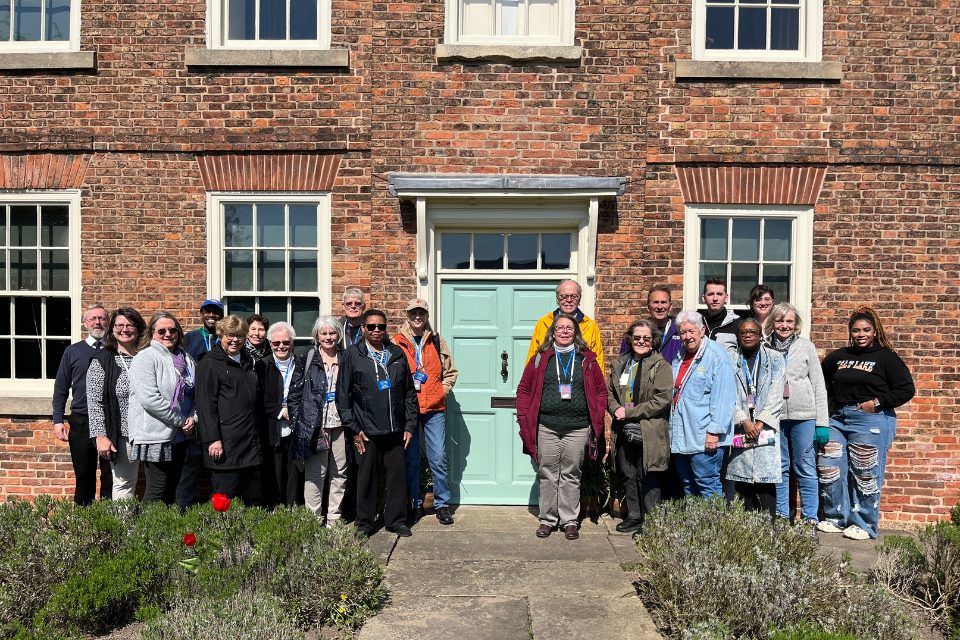A group of United Methodists from Michigan traveled to England to learn more about their Wesleyan heritage and how it continues to shape beliefs and inspire future mission.
JAMES DEATON
Content Editor
Studying religious history can be dry and dusty, and it can feel irrelevant and disconnected from contemporary issues and life. Still, there are ways to look back that can enrich our faith and inspire us for ongoing mission in a new era.
Twenty United Methodists from the Michigan Conference had the opportunity to experience Methodist history in a living classroom as they participated in a Wesleyan heritage tour of England.
For ten days, from April 16-25, 2023, these pilgrims walked the steps of John Wesley, the founder of Methodism, and his brother Charles. And they experienced a renewed sense of purpose as uniquely United Methodist Christians.
They traveled to the small town of Epworth to learn about the Wesleys’ rural beginnings, to Oxford where they studied and formed their Holy Club, to Bristol on the southwest coast where Charles lived and wrote thousands of hymns, to London where John had his heart-warming experience at a meeting on Aldersgate Street, and to a few additional stops along the way.
The group also met faith siblings from the Methodist Church in Britain and experienced the connectional spirit that ties us together through worship, Holy Communion, and fellowship.

Rev. Faith Fowler, pastor of Cass Community UMC, organized this heritage trip through Educational Opportunities Tours, a Christian travel ministry known for its quality Wesleyan tours, for her congregation but opened it up to others to join them.
The trip had members from several United Methodist congregations, including Cass Community, Birmingham: First, and Ann Arbor: First UMCs. There was a diverse mix of lifelong United Methodists, people who grew up in other Christian traditions, and a few who were new to the Christian faith.
Rev. Fowler was one of four clergy members on the trip. Retired pastor Rev. Jack Harnish, Rev. Elizabeth Hurd, pastor of West Bloomfield UMC, and Rev. Sue Pethoud, a deacon serving as Church and Community Relations Liaison for Cass Community Social Services in Detroit.
Faith wanted people from her congregation, especially those who didn’t grow up hearing stories about the Wesleys in sermons and Sunday school classes, to know their denomination’s history better.
Also, in light of the fact that The United Methodist Church, through this season of disaffiliation, is having an identity struggle, Faith wanted the pilgrims to experience Methodist history in its context and appreciate our faith heritage as it relates to both spirituality and social justice. In doing so, Fowler has hope that we will find keys to our life of faith moving into the future.
“I think looking back helps you figure out the way forward,” Fowler noted. “And I believe that [spirituality and social justice in Wesleyan theology] are married—two sides of the same coin—and have been from the very beginning.”

Looking back doesn’t mean seeing our United Methodist history with rose-colored glasses or nostalgia for how things used to be. Looking back means seeing our faith forbears—often larger-than-life heroes—honestly and truthfully as imperfect saints of God with lessons to teach us. It means understanding the complexities of our history and the architects who built it.
The Michigan pilgrims looked at early Methodism through several windows of history as they traveled by bus around England (click here to view the itinerary), hearing the stories, sharing insights, and thinking about how this history shapes Christian faith and practices today.
One aspect of John Wesley’s approach to ministry that struck Rev. Fowler was how hard John worked at building community. “You had the classes, the bands, the decision to let women preach, the empowerment of laity, which is so strong in our history, and sometimes we forget it. The church is not built on individual preachers. It takes that community, and Wesley knew it.”
This expression of community that is so integral to the spirit of Methodism began with the Holy Club, which was started by the Wesley brothers while studying at Oxford. Out of the Holy Club came the development of the Wesleyan class meetings, a form of discipleship and accountability where, according to Rev. Jack Harnish, there were opportunities for personal spiritual growth and being active in the community. He said, “The prisons were dreadful, and they would go into them and take food and blankets. It wasn’t just coming together for Bible study and prayer, but they would also be involved in the community.”

Rev. Elizabeth Hurd heard the stories of how John broke out of the institutional church and went to where people were, making his ministry about meeting the physical and spiritual needs of people. And she wonders how The United Methodist Church can be relevant today like Wesley was relevant back then.
She said, “We’re at the cusp of a changing world, and it’s important to think about how we can go beyond ourselves and be out in the world. If a dead white man from the eighteenth century can resonate with people so well in the twenty-first century, what’s stopping the church from the twenty-first century from replicating that idea? Where are the ways that we could take what Wesley was doing and apply it to our time? That’s what really got sparked for me.”
This question of finding relevancy in John Wesley’s methods also stood out for Rev. Sue Pethoud. It’s what drew her to The United Methodist Church from the Episcopal tradition. “What brought me to the UMC was the values that Wesley had as a founder of the movement. Going forward, any church that’s going to survive has to not be in its building. They must be out doing ministry with the people in the neighborhood. And that’s what John Wesley did.”
As a young clergyperson, Rev. Elizabeth Hurd is excited to focus on moving into the community as one way to move forward in The United Methodist Church. “We have to recapture that spirit of innovation and have people who are brave enough to go and do whatever the equivalent of field preaching is, to go and be engaged in the community and share God’s love and operate outside the walls of the church. That, for me, was really inspiring.”

But, when looking closely at history, it’s important to remember that the social justice lens of Methodism is balanced by a heart conviction to proclaiming the gospel. Rev. Hurd explained, “At times, we focus so much on the social justice work of supporting women preachers or supporting the abolitionist movement, those sorts of things, that we forget that a lot of what they did was done with the aim of showing God’s love to people whom the church was missing. That evangelism piece, that dedication to bringing people to Christ, was really important.”
Rev. Jack Harnish, a lifelong student of United Methodist history, echoed this desire for balance within Methodism, one that will continue in the future. “I think the balance that we always strive for and never achieve is that between personal piety and social commitment. ‘My heart strangely warmed’ and ‘The world is my parish’—these phrases represent the balance of Methodism.”
The Methodist pilgrims from Michigan learned much about the roots of Methodism and this grassroots movement of all people—clergy and lay—that is rooted in communities of faith, small groups of Christ-followers who are committed to sharing the life-changing message of the gospel with others, especially those on the margins, those society has left out.
This Methodist movement, rooted in historical places and times, inspires young and old alike and draws people to its distinct approach to discipleship: God’s prevenient grace is already working in each of us and available to all. Salvation is not a once-and-done event, but something worked out throughout our lives, leading to perfection. Holiness, or Christian perfection, is a maturing of faith that allows the love of God to permeate our lives in such a way that we share that love with others through personal acts of piety and social justice.
Last Updated on October 27, 2023

